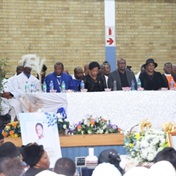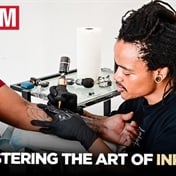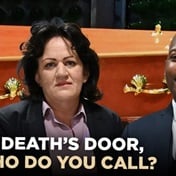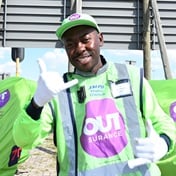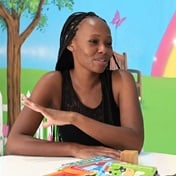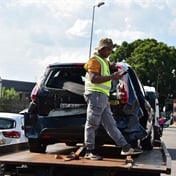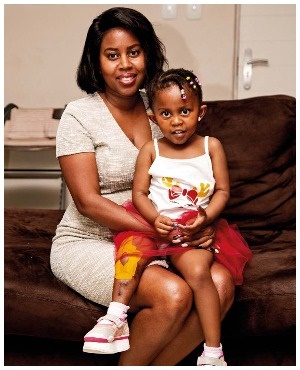
They were a mom and dad with a dream to see their daughter walk on her own two feet in a pair of pretty shoes. Now their precious little girl is living proof that dreams do come true – and testimony to the fact that parents should sometimes stick to their instincts, no matter what medical professionals may tell them.
After a long year toing and froing between home in Johannesburg and Florida in the United States, the Moropa family are loving being back together. And bubbly little Phenyo (3) is indeed standing on her own two feet – and even trying out a few dance moves. “It’s nice seeing her walk, play around and do things,” the tot’s mom, Gillian (30), tells us when we meet them at their home in Midrand.
“She’s adjusting and it’s going to be a process but she’s doing better than I thought,” she adds. Gillian and Phenyo are back in South Africa after spending almost a year in America where Phenyo underwent surgery to correct her tibial hemimelia. The congenital lower limb condition – which affects one in every million babies worldwide – resulted in a shortened right tibia (shin bone), leaving Phenyo’s leg deformed and her foot turned in.
Doctors urged Gillian and her husband, Tshepo (33), to amputate their baby’s leg but the couple refused. There had to be something that could be done for her, they thought. They did extensive research and eventually came across orthopaedic surgeon Dr Dror Paley, who specialises in limb-lengthening and deformity correction at the Paley Institute in West Palm Beach, Florida.
Gillian and Tshepo spent almost two years raising the $70 000 (R1 million) required for Phenyo to have the lifechanging surgery – and today she can put on her favourite shoes.
Mother and daughter made the move to America on 16 September last year and Phenyo was due for her first surgery four days later. The first op was to attach a fixator, the name of a device that would gradually lower her fibula (calf bone). The fixator extended above her knee, says Gillian, who had to make 1mm turns on the six struts of the fixator every day.
“It was basically pulling the fibula down to where it should be, which is below her knee next to her tibia,” adds Gillian, who gave up her job as a store buyer to become a stay-at-home mom after Phenyo was born. That process took about two-and-a -half months. Tshepo joined them for a week while their son, Koketso (12), stayed with family in South Africa so he could continue going to school.
The next phase was to turn her foot to face the right direction via a fixator. Gillian says the rotation came with a few complications because Phenyo’s foot took longer than expected to turn. “It took an extra month just to rotate it. The process took about three months.”
Phenyo had her second operation in February 2019, where surgeons fused her fibula to her foot and attached it to the tibia to form one bone. The more Phenyo walks and puts weight on the leg, the more the bone will densify and be able to carry her weight, Gillian says.
“After the second surgery we stayed a few weeks and then we came home for three months. The bone just needed to attach itself and heal.”
While back in SA, Phenyo went for physiotherapy to help her walk and learn how to bend her knee. And then it was back to the US for what was supposed to be her final surgery. On 20 June, her fixator was removed and her leg was put in a cast for four weeks. But a few days before they were due to return to South Africa her leg started turning, forming a knock knee.
“It’s not unusual with kids with her condition,” Gillian says. “So her fourth surgery was a minor out-patient procedure where they put in what they call an eightplate, which assists the leg to grow straight.” Finally the little girl was good to go.
Tshepo, a metallurgist, says he and Gillian went shopping for shoes for their baby daughter even before she was born. “But for the first years of her life, she couldn’t wear them,” he says – so for Tshepo to finally see shoes on his little girl’s feet was quite an experience.
“It was emotional, an indescribable feeling. I think it was fantastic even for her because now she’s able to tell us which shoes she wants,” he says.
Gillian says Phenyo was a bit upset after her first surgery but quickly shifted gears. “The moment she realised she was standing and when she started walking in the fixator – that’s when the joy started coming.”
Phenyo is adjusting to her new world. She’s been enrolled in a crèche, but her play times are not the same as an average three-year-old for now. “When kids her age play outside they put her with the smaller kids,” Gillian says.
“It was a bit of an adjustment for her but I think she kind of gets it because we have to protect her leg. We can’t afford for her to fall or break it.”
Phenyo’s biggest challenge is learning to bend her knee and she tends to walk with her leg straight. Her parents take her for physio sessions three times a week and on the other days Gillian does the exercises with her. Her shoes are elevated on the right side because her right leg is shorter than her left. Gillian says she might have to go back to the US for lengthening in her teens.
Big brother Koketso is just glad the family is back together again.
“Now things can get back to normal,” he says, although he adds that some things have changed. “We don’t do all the things we used to do before.”
They’ve had to cut down on family outings due to the financial burden that came with Phenyo’s care but Gillian says they had to give their daughter a chance. “[When Phenyo was born] I didn’t know what to do. I had to change how I think and learn to accept the lessons that came with it. I looked at it and said, ‘This is a war and I’m not losing’.”
Gillian says they’re in contact with three other families in South Africa who are going through similar experiences with their kids and hopes a time will come when treatment is available in South Africa.
“I hope and pray we can get to a point where South African doctors say, ‘Let’s go to Dr Paley and find out what he’s doing differently’.”
But for now most of her attention is on getting her daughter walking – and dancing – with confidence.










